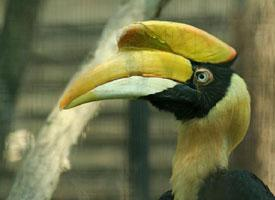
Popis zvířete
The Southern ground hornbill (Bucorvus leadbeateri) is a striking bird species that belongs to the Bucerotidae family, which also includes other hornbills. Native to the savannahs, grasslands, and woodlands of sub-Saharan Africa, this remarkable bird is the largest species of hornbill found on the African continent. Characterized by its distinctive appearance and intriguing behaviors, the Southern ground hornbill plays a significant role in its ecosystem and holds cultural importance in many African societies.Physical Description
Adult Southern ground hornbills are imposing birds, standing up to 90 to 130 cm tall, with a wingspan that can reach up to 180 cm. They exhibit a sexual dimorphism in size, with males being larger than females. One of the most striking features of this bird is its vividly colored facial and throat skin, which contrasts sharply with its predominantly black plumage. The males have bright red patches of bare skin on their face and throat, while females can be distinguished by a patch of violet-blue skin in the same area. They have a long, down-curved bill that is black in color and topped with a casque, a feature characteristic of hornbills. Their eyes are surrounded by long eyelashes, an unusual trait among birds.
Behavior and Ecology
Southern ground hornbills are ground-dwelling birds, spending most of their time walking in search of food. Their diet is omnivorous but predominantly carnivorous, feeding on insects, snakes, small mammals, and occasionally, plant matter. They hunt in groups, using their strong bills to dig or break into hard surfaces to access prey.
These birds are highly social, living in groups of 2 to 12 individuals, which are usually family units comprising a breeding pair and their offspring from different years. Southern ground hornbills have a cooperative breeding system, where non-breeding members of the group assist in raising the young. This species is known for its low reproductive rate, typically raising only one chick to adulthood every two to three years. They nest in large cavities in trees or cliffs, where the female lays 1 to 2 eggs. The entire group participates in feeding and protecting the nestlings.
Vocalization
The Southern ground hornbill is renowned for its deep, booming calls, which can be heard up to 3 kilometers away. These calls play a vital role in communication within the group, territorial defense, and attracting mates. Their vocal repertoire includes a variety of sounds, from grunts and growls to the characteristic booming calls.
Conservation Status
The Southern ground hornbill is classified as Vulnerable by the International Union for Conservation of Nature (IUCN). Their populations are declining due to habitat loss, human-wildlife conflict, and poaching. Being slow breeders, their populations are particularly vulnerable to these threats. Conservation efforts are underway to protect their habitats and mitigate threats. These include captive breeding programs, reforestation projects, and community-based conservation initiatives that involve local people in the protection of these magnificent birds.
Cultural Significance
In many African cultures, the Southern ground hornbill is revered and often associated with rain, fertility, and good fortune. Some tribes consider it a taboo to kill them, believing it can bring bad luck. Their presence in folklore and traditional ceremonies underscores the deep connection between these birds and the cultural heritage of the people who share their habitat.
In summary, the Southern ground hornbill is a fascinating and unique bird species, with distinctive physical traits, complex social behaviors, and an important ecological role. Efforts to conserve this species are crucial for maintaining the biodiversity of African savannah ecosystems and preserving the cultural heritage that surrounds these iconic birds.
Podobná zvířata
Nové fotografie zvířat
Top 10 zvířat
- Dolphin gull (Leucophaeus scoresbii)
- Diana monkey (Cercopithecus diana)
- Moustached guenon (Cercopithecus cephus)
- Galápagos tortoise (Geochelone nigra complex)
- Stone loach (Barbatula barbatula)
- Japanese macaque (Macaca fuscata)
- Russian tortoise (Testudo horsfieldii)
- Greek tortoise (Testudo graeca)
- Common flying dragon (Draco volans)
- Vendace (Coregonus albula)

